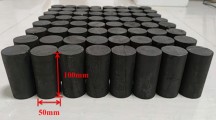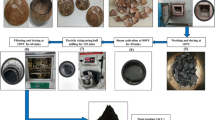Abstract
Pore structure is an important factor influencing coke strength, while the property of coke is essential to maintaining gas and liquid permeability in a blast furnace. Therefore, an in-depth understanding of the pore structure evolution during the graphitization process can reveal the coke size degradation behavior during its descent in a blast furnace. Coke graphitization was simulated at different heating temperatures from 1100 to 1600°C at intervals of 100°C. The quantitative evaluation of the coke pore structure with different graphitization degree was determined by vacuum drainage method and nitrogen adsorption method. Results show that the adsorption and desorption curves of graphitized coke have intersection points, and the two curves did not coincide, instead forming a “hysteresis loop.” Based on the hysteresis loop analysis, the porous structure of the graphitized coke mostly appeared in the shape of a “hair follicle.” Furthermore, with an increase in heating temperature, the apparent porosity, specific surface area, total pore volume, and amount of micropores showed good correlation and can divided into three stages: 1100–1200, 1200–1400, and 1400–1600°C. When the temperature was less than 1400°C, ash migration from the inner part mainly led to changes in the coke pore structure. When the temperature was greater than 1400°C, the pore structure evolution was mainly affected by the coke graphitization degree. The results of scanning electron microscopy, energy dispersive spectrometry, and ash content analyses also confirmed that the migration of the internal ash to the surface of the matrix during the graphitization process up to 1400°C contributed to these changes.
Similar content being viewed by others
References
J.J. Cai, J.J. Wang, Z.W. Lu, and R.Y. Yin, Material flow and energy flow in iron and steel enterprises and their relationship, J. Northeastern Univ. Nat. Sci., 27(2006), No. 9, p. 979.
Z.Y. Chang, P. Wang, J.L. Zhang, K.X. Jiao, Y.Q. Zhang, and Z.J. Liu, Effect of CO2 and H2O on gasification dissolution and deep reaction of coke, Int. J. Miner. Metall. Mater., 25(2018), No. 12, p. 1402.
J. Fang, X.J. Wang, R.J. Gong, and R.X. Ren, Simulative research on coke strength in lumpish section of blast furnace, J. Iron Steel Res., 19(2007), No. 1, p. 12.
M.M. Sun, J.L. Zhang, K.J. Li, K. Guo, Z.M. Wang, and C.H. Jiang, Gasification kinetics of bulk coke in the CO2/CO/H2/H2O/N2 system simulating the atmosphere in the industrial blast furnace, Int. J. Miner. Metall. Mater., 26(2019), No. 10, p. 1247.
H.J. Jin and Y.N. Fu, Changes in pore structure during coke-CO2 reaction, Coal Chem. Ind., 1991, No. 1, p. 11.
T. Hilding, S. Gupta, V. Sahajwalla, B. Björkman, and J.O. Wikström, Degradation behavior of a high CSR coke in an experimental blast furnace: Effect of carbon structure and alkali reactions, ISIJ Int, 45(2005), No. 7, p. 1041.
S.S. Gornostayev and J.J. Härkki, Graphite crystals in blast furnace coke, Carbon, 45(2007), No. 6, p. 1145.
M. Grigore, R. Sakurovs, D. French, and V. Sahajwalla, Coke gasification: The influence and behavior of inherent catalytic mineral matter, Energy Fuels, 23(2009), No. 4, p. 2075.
T. Qiu, J. G. Yang, and X. J. Bai, Insight into the change in carbon structure and thermodynamics during anthracite transformation into graphite, Int. J. Miner. Metall. Mater., 27(2020), No. 2, p. 162.
S. Gupta, V. Sahajwalla, P. Chaubal, and T. Youmans, Carbon structure of coke at high temperatures and its influence on coke fines in blast furnace dust, Metall. Mater. Trans. B, 36(2005), No. 3, p. 385.
M.J. Ma, S.J. Zhang, Y. Yan, and Y.G. Wang, Research progress of coke structure, China Coal, 32(2006), No. 8, p. 54.
R. Guo, Q. Wang, X.F. Zhao, and J.F. Sun, Reactivity and post-reaction properties of coke and their measurement, Chin. J. Process Eng., 13(2013), No. 3, p. 512.
H.B. Zuo, Y. Rong, J.L. Zhang, X.B. Wu, and B. Gao, Effect of CaO on properties of coke, Iron Steel, 49(2014), No. 1, p. 7.
D.S. Hu, Crystallite structure characteristics of coke, Iron Steel, 41(2006), No. 11, p. 10.
H. Shi, J.N. Reimers, and J.R. Dahn, Structure-refinement program for disordered carbons, J. Appl. Cryst, 26(1993), No. 6, p. 827.
Y.Z. Fang, Y.P. Cao, M.L. Jin, J.H. Yang, and Z.F. Qian, Effect of anthracite in coal blend on micro-crystal and pore structure of coke, Iron Steel, 41(2006), No. 10, p. 16.
S.M. Shin, I.H. Jeong, and S.M. Jung, Graphitisation effect of coke with changing annealing time and temperature on pore structure and apparent gasification rate with H2O, Ironmaking Steelmaking, 45(2018), No. 8, p. 739.
D.S. Xing and W.P. Yan, Analysis of pore structure of typical semi-cokes by mercury porosimetry, J. North China Electr. Power Univ., 34(2007), No. 5, p. 57.
G.Z. Yang, Y.Y. Xu, S.Z. Wei, L. Yao, and J.H. Yang, Study on ash and microstructure of coke at elevated temperature, Coal Convers., 38(2015), No. 4, p. 54.
L. Maria, K. Rita, S.Ö. Lena, S. Veena, and B. Björkman, The evolution of structural order as a measure of thermal history of coke in the blast furnace, Metall. Mater. Trans. B, 45(2014), No. 2, p. 603.
Z.G. Zhao, Application Principle of Adsorption, Chemical Industry Press, Beijing, 2005, p. 631.
R. Bardestani, G.S. Patience, and S. Kaliaguine, Experimental methods in chemical engineering: specific surface area and pore size distribution measurements—BET, BJH, and DFT, Can. J. Chem. Eng, 97(2019), No. 11, p. 2781.
Acknowledgements
This work was financially supported by the National Natural Science Foundation of China (Nos. 51604148, 51874171, and 51974154) and the Science Foundation for the Talents by University of Science and Technology Liaoning (USTL), China (2019RC11).
Author information
Authors and Affiliations
Corresponding authors
Rights and permissions
About this article
Cite this article
Zhu, Hb., Zhan, Wl., He, Zj. et al. Pore structure evolution during the coke graphitization process in a blast furnace. Int J Miner Metall Mater 27, 1226–1233 (2020). https://doi.org/10.1007/s12613-019-1927-1
Received:
Revised:
Accepted:
Published:
Issue Date:
DOI: https://doi.org/10.1007/s12613-019-1927-1




